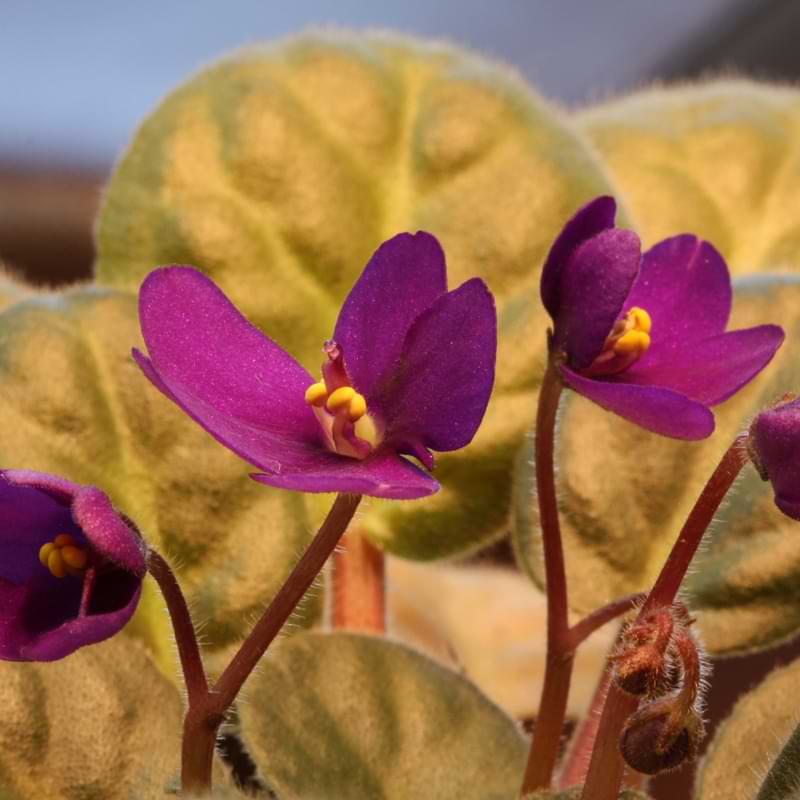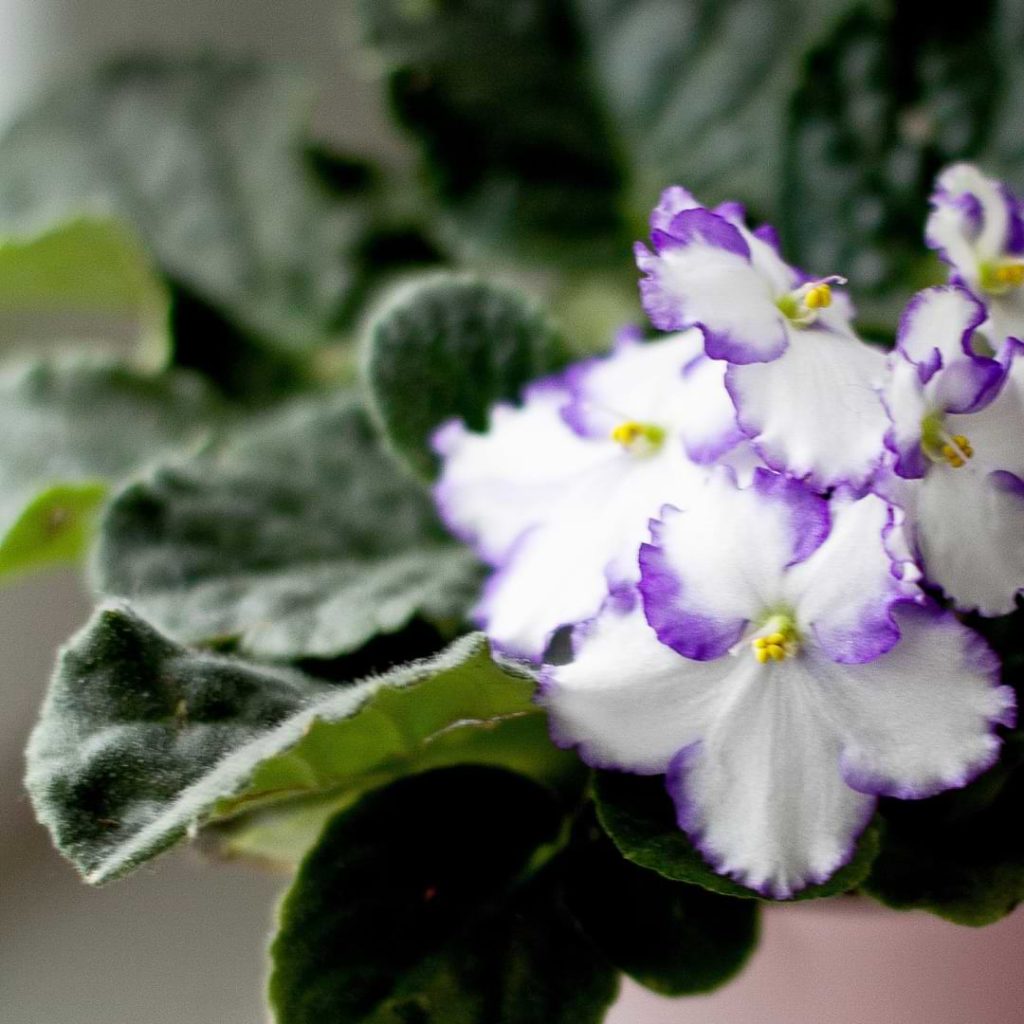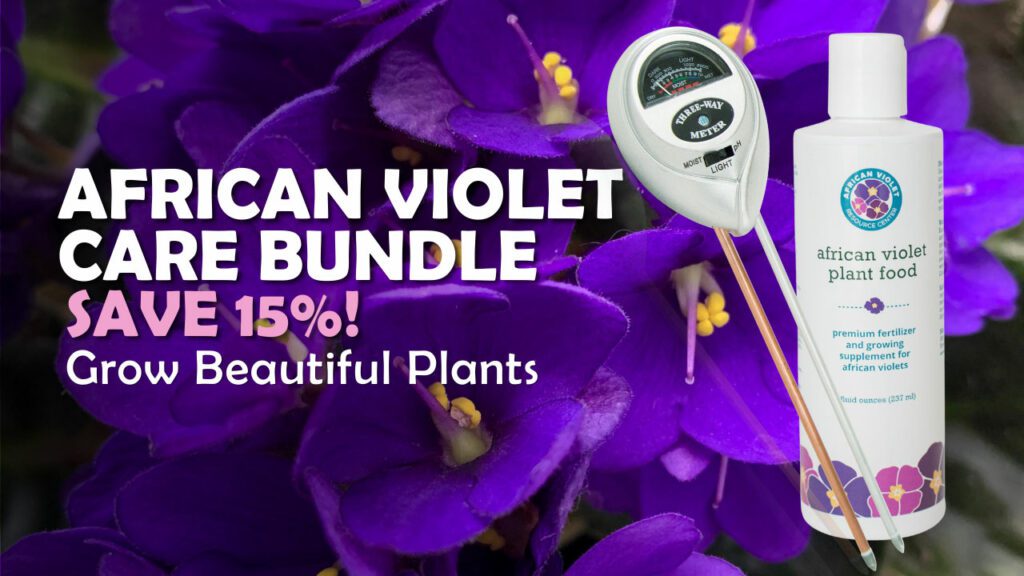With bright blooms and lovely fuzzy leaves, it’s no wonder African violets are beloved the world over. But nothing is more stressful than when your plant starts to struggle—and you don’t know why!
Leaf changes are one of the first ways your plant will signal something isn’t right in its environment. And whether you’re dealing with brown spots, crispy edges, or a mysterious powdery intruder, you’ll need to take immediate action to correct what isn’t working.
Luckily, most African violet leaf problems are an easy fix! This beginner-friendly guide will walk you through some common symptoms, and what you need to do next.
Problem #1: African Violet Leaves Curling
African violet leaves curling under is one of the most common issues you can experience with your plant. That’s because this symptom is usually caused by one of the African violet’s two biggest enemies: cold air and direct sunlight. If you notice this issue, don’t panic. Both causes are an easy fix.
Likely Culprit: Cold Air
Like many of us, African violets like to be cozy. And—also like us—they tighten and huddle up to conserve heat when they get cold. If your African violet’s leaves are curling under and turning brittle, they’re not warm enough! You may also notice your plant has grown extra “fur” on its leaves to protect itself. (Poor thing!)
If you think cold air is the culprit, rescue your African violet from that drafty hallway or chilly great room and transport it somewhere more pleasant. Your plant will be happiest in a space with a steady temperature of 68-70ºF. If you have trouble maintaining a consistent temperature in your home during winter months, consider supporting your plant with a small heat lamp or grow light.
Likely Culprit: Too Much Sunlight
If you’re certain your plant hasn’t caught a chill, too much sunlight might be to blame. African violets like bright, indirect sunlight. But when they’re placed in hot, direct sunlight, their leaves can start to suffer. If your plant is placed in a windowsill—or a particularly sunny room—too much sunlight might be causing its leaves to curl under. The remedy? Sweet, sweet shade.
Problem #2: African Violet Leaves Turning Brown
African violets are known for their lush, deep-green foliage. That’s why brown, crispy leaves are a clear sign that something has gone wrong. Several issues can cause this symptom in your plant. We’ll take a look at two of the main culprits, and provide resources for further investigation.
Likely Culprit: Water Spotting
African violet leaves are extremely sensitive to water. In the wild, they’re protected from heavy rain and direct sunlight by the forest canopy. Unfortunately, your home isn’t a jungle! If you accidentally get your plant’s leaves wet while watering, and they’re exposed to direct sunlight, it can lead to brown spots and sunburn. Unfortunately, if this is the case, the affected leaves won’t recover. They’ll need to be removed. But don’t worry—the rest of your plant should pull through just fine!
Likely Culprit: Too Much Fertilizer
If your plant’s leaves are brown and crispy around the edges—rather than brown spots throughout the leaf—you may have some issues below ground. African violets have delicate root systems that can easily struggle when exposed to overfertilization. And their leaves are the first place they send up the SOS.
Examine the pot for salt buildup on the soil, leaves, or rim of your pot. If you notice orange or yellow-ish crystals, gently flush the soil with room-temperature water (while avoiding the leaves). We recommend using a gentle, urea-free fertilizer moving forward to prevent nutrient buildup underground.
Not the culprit you’re looking for? See our blog 5 Reasons African Violet Leaves Turn Brown.

Problem #3: African Violet Leaves Turning Yellow
A healthy plant will have rich, green foliage. When a leaf yellows, it’s a likely sign it’s starting its journey to the great greenhouse in the sky. But while this African violet leaf problem usually means you’ll lose the foliage, it doesn’t mean the whole plant is sick. Here’s why:
Likely Culprit: Water Shock
We know what happens when you expose wet African violet leaves to sunlight: they turn brown and burn. But getting African violet leaves wet in general can still cause problems. That’s because water that’s colder or warmer than your plant’s base temperature can shock and kill the cells in the leaf. The result? Yellow leaves and bleached spots.
Unfortunately, if this happens, the leaf won’t recover. Trim the affected leaves and adopt a bottom-watering practice to avoid this problem in the future.
Likely Culprit: Old Age
Each leaf on an African violet will live about a year. As it nears the end of its life cycle, your plant will stop sending nutrients in its direction; instead, it saves that energy for higher-functioning foliage. African violets grow from the crown outward, so if you notice the leaves closest to the surface turning yellow, they’re probably on their way out. Feel free to trim them and thank them for their service.
Problem #4: African Violet Leaves Drooping or Limp
Uh oh! Your African violet leaves have lost their vigor. Now they’re limp and droopy. This is a sign your plant can’t properly deliver nutrients to its cells. The two main culprits are opposites, but they have the same outcome: a very unhappy houseplant.
The Culprit: Underwatering
If your plant isn’t getting enough water, it won’t be able to keep its leaves healthy and firm. Diagnose this issue by checking the soil: is it bone-dry? If so, your plant baby is dehydrated! Set it in a tray of room-temperature water and allow it to take up as much water as it needs through the holes in the bottom of its pot. Bottom water moving forward, checking water levels every few days.
The Culprit: Overwatering
The sneaky cousin to underwatering, overwatering can be even more dangerous to your plant. When an African violet stays in oversaturated soil for too long, air can’t reach the roots. This creates prime conditions for root rot and fungus. If the soil feels damp or mushy, remove your plant from its soil and check for root rot. Trim black or gunky sections, and repot in specialty African violet mix.
Learn more about treating this common African violet leaf problem with our blog on African Violets With Droopy Leaves.
Problem #5: Brown Spots on African Violet Leaves
Brown spots can be caused by exposing wet leaves to sunlight. But if they’re developing near the center of the leaf and your plant appears otherwise healthy, sunlight may not be the culprit. Instead, you may have an invisible intruder in your water supply.
The Culprit: Chloramines in Your Water Supply
Chloramines are disinfectants commonly used to treat drinking water. In small amounts, they’re harmless to humans. But if you’re watering your plant with tap water, they may be responsible for this African violet leaf problem. If you suspect your water contains chloramines, try boiling for a short period to reduce the concentration (be sure to let it return to room temperature before exposing your plant) or consider using store-bought water at bath time.
Problem #6: African Violet Leaves Turning White
With winter comes snow—and, unfortunately, snow-like fungus. If you notice white blotches across your African violet’s leaves during the colder months, quickly isolate your plant: you may have a pesky intruder.
The Culprit: Fungal Disease
White mildew is a common fungal disease that affects indoor plants. Toasty temperatures and closed windows make winter months an ideal breeding ground for this powdery pest. If your plant has fallen victim, remove all affected foliage and isolate it in a room with better circulation (or near a small fan) while you monitor for additional outbreaks.
African Violet Leaf Problems: Common Beginner FAQs
FAQ 1: How Do I Bring My African Violet Back to Life?
We’ve answered a few specific questions about African Violet leaf problems. But what if your plant is, well, just not doing so hot?
Although they’re known for being finicky, African violets actually are quite hardy in the right conditions. Our blog 6 Signs Your African Violet Is Dying can help you identify what needs fixing and revive your plant before it’s too late. Once you’ve averted disaster, follow these five tips to keep your African violet alive for years to come.
FAQ 2: How Do I Know if My African Violet Is Healthy?
If your African violet is healthy, you’ll know it! These gorgeous plants grow vigorously, and are known to bloom nearly all year round. If you’ve got vibrant flowers, strong growth, and firm, fuzzy leaves, keep doing what you’re doing!
Monitor your plant regularly for African violet leaf problems, flower loss, or soil issues—and correct any inconsistencies before they become a bigger issue. Master your process with Do This, Not That!, an easy guide to beginner African violet care.
What else would you like to know about African violets? Join the conversation in our Facebook group.
Join the African Violet Club!
Whether you’re just starting out or are a seasoned grower, African Violet Resource Center has everything you need to help your plant grow vibrant and strong. Explore our other articles, visit our online shop, and connect with other houseplant lovers in our Facebook group to learn everything you need to know about this rewarding hobby!
More Great African Violet Resources
How to Remedy Crowded African Violet Leaves
Where to Buy African Violet Plants & Products







